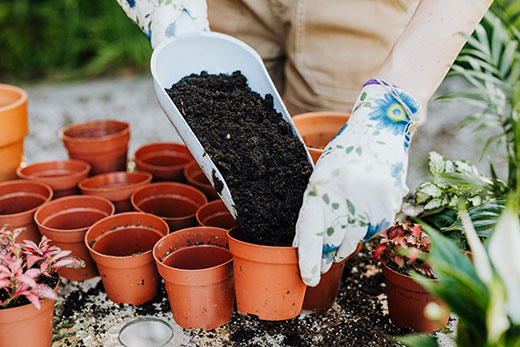
All potting mixes are not the same. K-State nursery crop production and marketing specialist Cheryl Boyer advises gardeners to read package labels before purchasing potting materials.
Soil Sense: Potting materials make a difference when growing plants in containers
K-State’s Boyer outlines key components of potting media
June 12, 2023
By Pat Melgares, K-State Research and Extension news service
MANHATTAN, Kan. – Not all soil-less potting materials are created equal. Just ask your potted plants. Or, better, ask Cheryl Boyer.
“There are a lot of (potting mixes) that you can use to grow plants in,” said Boyer, a nursery crop production and marketing specialist with K-State Research and Extension. “It actually matters how big the particle sizes are, and what they are composed of.”
Listen to an interview by Jeff Wichman with Cheryl Boyer on the weekly radio program, Sound Living
For bigger containers, she says, gardeners should choose potting mixes with bigger pieces, “because they’ll break down over time.”
“But for a smaller container, you want potting mixes with smaller pieces that also include components that have a good water-holding capacity so that when it gets hot and dry, there are resources in the container for the plants to survive.”
The ingredients in potting mixes also make a difference. Boyer said gardeners should be like any good consumer: Read the label before purchasing a particular mix.
“The ingredients in potting media will influence how your plants perform in containers,” she said. “For example, probably the worst thing you could put in a container is field soil, and there are quite a few products that are just bagged field soil. There’s just not enough air space in field soil, and it will tighten up like concrete and make it so plants can’t explore and get the nutrients they need.”
What to look for? Boyer suggests:
- Spaghnum peat moss, a Canadian-mined product that comes in various species, sizes and coarseness.
- Pine bark. For Kansas-grown plants, pick a product that is low in acidity, or pH. “If you put low pH items in the potting media, our water – which might be high in pH or be considered alkaline – will begin to balance that out and provide a neutral environment for plants.”
“Pine bark and peat moss are going to be your major components, and maybe some sand (for weight),” she said.
Minor components in bagged potting soil include perlite and vermiculite, which Boyer says are “inorganic materials that are included for airspace or particle size.”
“Vermiculite is often used in plant propagation where you need a lightweight media that the roots can grow easily into, and then you shift it into a larger container that has more structure to it,” she said. “Perlite is those little, white expanded volcanic materials; a lot of people think that’s fertilizer, but it’s not fertilizer at all. It is really just for air space.”
Research indicates that wood bark and wood-based substrates can be a viable substitute for perlite, according to Boyer. “There are a lot of common materials that continue to be used and we are innovating these products to make them available for consumers to use for growing plants.”
She adds: “There are a lot of things that you might see in potting media. Many of them will promote that they’re organic, but most of these products are organic by nature – they just may not have gone through the organic certification process. But it’s hard to go wrong with a lot of the potting media that we have, and they come in different sizes of bags and price ranges.”
Boyer said gardeners should also look for mixes with a “starter charge,” which means that fertilizer was added before the product was bagged.
“If it’s going to go in a container for your annual plants, it’s really nice to have some fertilizer already mixed in so that plants have something to eat as soon as you get them in the container,” she said.
Boyer urges gardeners to consult with their local garden center. More information also is available at K-State Research and Extension’s local offices across the state.

